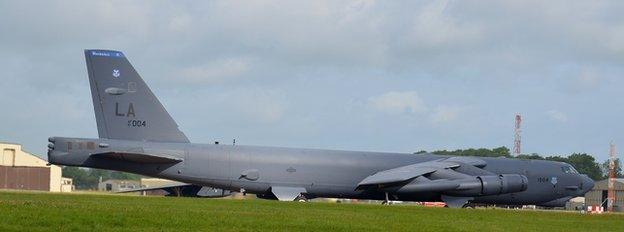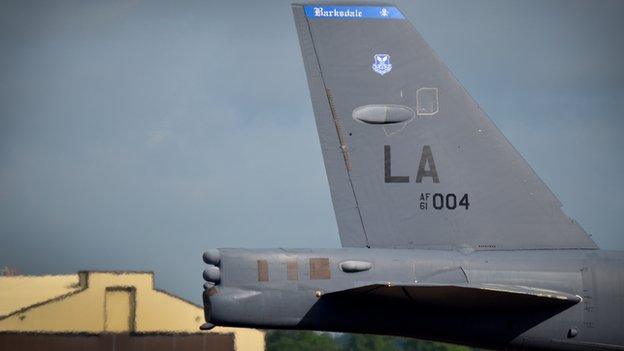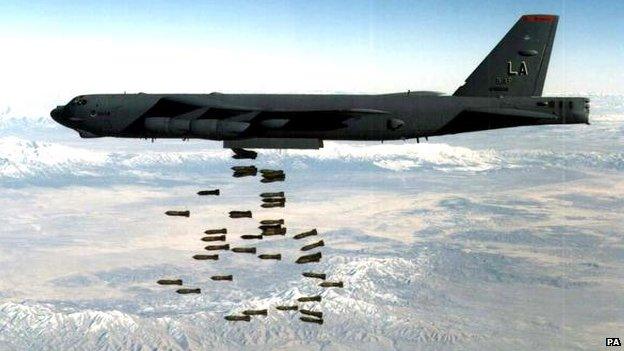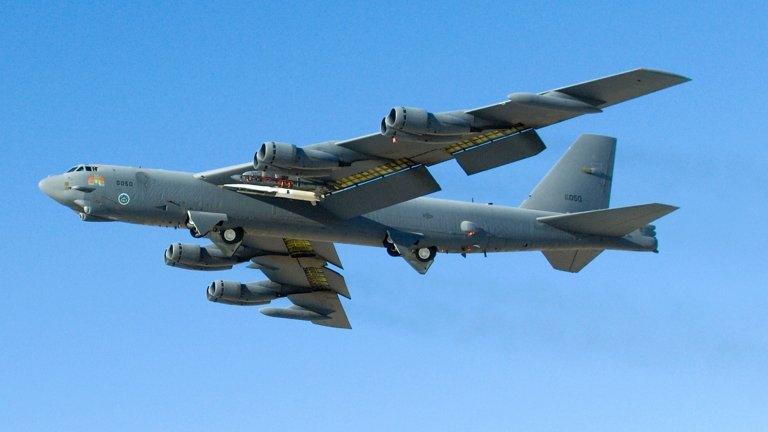The B-52 bomber: Long-standing symbol of US strength
- Published

The Boeing B-52 - sometimes known as the Stratofortress - is a long-range, jet-powered strategic bomber that is widely expected to prop up the US Air Force well beyond the year 2045
Before our marathon eight-hour flight, Capt Thomas Hyde, the commanding officer of one of the B-52 bombers, briefly describes the mission.
He says we will be doing a number of simulated bombing runs around what he calls "the island". He makes it sound like a short training flight over a remote abandoned outcrop of rock somewhere in the North Sea. But the island he is referring to is in fact Britain.
It is the first time the B-52s have returned to their European "home" for more than a decade.
RAF Fairford in Gloucestershire is one of the long-range bombers' forward operating bases - alongside the more exotic islands of Guam and Diego Garcia.
Military muscle
The last time they were in Europe was in 2003 - the year America launched "shock and awe" on Iraq.
Jonathan Beale had exclusive access to one B-52 on a training sortie
Now their arrival is more about flexing America's military muscle.
But it is seen as significant given Russia's recent intervention in Ukraine.
Col Leyland Bohannon of the US Air Force says the timing is "interesting" while insisting it is "not connected".
But he adds wherever you fly a nuclear capable bomber "it does send a message".
The B-52 is a warrior of the Cold War. But it is still a symbol of American power.
The one we are flying in was built in 1961. It has since undergone numerous upgrades.
And while the B-52 was once used to conduct "carpet bombing" now it is more likely to carry cruise missiles and Laser Guided Bombs.
'Offensive weapon'
It is also capable of delivering nuclear weapons - these days ones fitted to cruise missiles that can be fired well away from its target.

B-52 bombers are are known as Big Ugly Fat Fellows, or Buffs, among US servicemen
But in the cockpit you can still see the shutters fitted to protect the aircrew from the intense blast of a nuclear explosion.
It's areminder of the B-52's history as an offensive weapon of last resort, as well as its appearance in the film Dr Strangelove.
There is another, more light-hearted, reminder of the famous Stanley Kubrick satire in a safety briefing given just before our flight.
It shows a still from the film under explanations of how to exit the aircraft in an emergency.
But for this visit there are no real bombs to drop, yet alone ride. It has been announced that the three B-52s and their more modern stealth cousin, the B-2, will not be carrying any live weapons while in the UK.
Despite its hulky appearance, life on board for the crew is cramped. Beyond the cockpit it is more like a submarine than an aeroplane with red lights and screens the only illumination.
Behind the two pilots are the seats for the Electronic Warfare Officers.
For our trip their electronics have been covered in black dustbin bags to avoid being seen by our camera.
Below, down a small narrow ladder, sits the navigator and the weapons officer squeezed into a cupboard-sized space with numerous screens and buttons - including those used to launch the weapons from the massive bomb door below.
The plane has been designed to carry bombs and fuel rather than people.
Andrew, the officer directing the bombs and with his hand on the trigger, answers to the call sign "Mayhem".
Air traffic control refers to B-52s over the radio as "Doom-One-One". The US military is clearly happy to use call signs that do not hide their business.
The crew though are more vague as to where they drop their weapons in their simulated bombing runs over "the island".
Although as "Doom-One-One" criss-crosses Britain from Land's End to Scotland we do seem to spend a significant amount of time over the north coast of Wales and Merseyside.

Once used to conduct "carpet bombing" the B-52 is now more likely to carry cruise missiles and Laser Guided Bombs
The three B-52s and the two B-2s now at RAF Fairford are expected to return to the US at the end of the month.
Though their training here is all about being ready, the current volatile situation in the Middle East is another reminder that the crews can never be sure of where they might be flying over next.
With a range of 8,000 miles (12,900km) on just one tank of fuel, the B-52 is able to reach pretty much anywhere in the world.
It has already seen action during the war in Vietnam and more recently in Afghanistan and Iraq.
And with a lifespan of at least another 30 years it could still could be used in anger again.
The crew of the bomber are anxious to show in this training mission that in the era of so-called "smart bombs", their targeting is not indiscriminate.
It is a mix of new as well as old technology.
In the words of Capt Hyde, the B-52 is proof that "you can teach an old dog new tricks".
- Published27 November 2013
